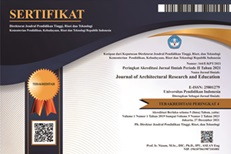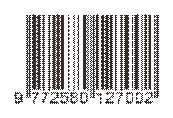Architecture as A Physical, Psychological & Spiritual Science, A Case Study on Indo-Aryan Architecture
Abstract
Keywords
Full Text:
PDFReferences
Akkach, S. (2005). Cosmology and Architecture in Premodern Islam; An Architectural Reading of Mystical Ideas. New York: State University of New York Press.
Alexander, C. (1979). The Secret of Timeless Architecture, The Timeless Way of Building. Oxford University Press.
Alexander, C. (1995, 2 10). Christopher Alexander Domestic Architecture. Retrieved 8 28, 2009, from Mediamatic: http://www.mediamatic.nl/Doors/Doors2/Alexander/Alexander-Doors2-E1.html
Ardalan, N., & Bakhtiar, L. (1979). The Sense of Unity, The Sufi Tradition in Persian Architecture. The University of Chicago Press.
Ayatollahi, H., & Haghshenas, S. (2003). The Book of Iran: the History of Iranian Art. Alhoda UK.
Bhattacharya, T. (1974). A Study on Vastuvidya or Canons of Indian Architecture. The United PRR Patna.
Blair, S. (1986). A Medieval Persian Builder. The Journal of the Society of Architectural Historians, Vol. 45, No. 4, 389-395.
Day, C. (2004). Places of the Soul: Architecture and Environmental Design as a Healing Art. Architectural Press.
Eliade, M., & Trask, W. (1968). The sacred and the profane. Houghton Mifflin Harcourt.
Fontana, D. (2003). Psychology, Religion, and Spirituality. Wiley-Blackwell.
Goel, N. (2000, 9). The Mandala - Sacred Geometry and Art. Retrieved 11 24, 2009, from Exotic India Art: www.exoticindia.com
Haider, S. G. (1988). Islam, Cosmology, and Architecture. In Theories and Principles of Design in the Architecture of Islamic Societies. Margaret Bentley Sevcenko. Cambridge, Massachusetts: Aga Khan Program for Islamic Architecture.
Hamlin, A. D. (1902). History of Architecture. Biblo & Tannen Publishers.
Hodson, G. (2015). Basic Theosophy. The Theosophical Publishing House.
Kent, S. (1993). Domestic Architecture and the Use of Space: An Interdisciplinary Cross-Cultural Study. Cambridge University Press.
Kumar, A. (2005). Vaastu: The Art And Science Of Living: The Art and Sciene of Living. Sterling Publishers Pvt. Ltd.
Marc, O. (1975). Psychology of the House. Thames & Hudson.
Master Choa Kok Sui. (2006). Miracles Through Pranic Healing: Practical Manual on Energy Healing. Philippines: Institute for Inner Studies Publishing Foundation.
Minorsky, V. (1971). Iran and Islam. Edinburgh: Edinburgh University Press.
Nasr, S. H. (2003). Islam: religion, history, and civilization. Harper San Francisco.
Oliver, P. (1997). Encyclopedia of Vernacular Architecture of the World. Cambridge University Press.
Pirnia, M. K. (2004). Understanding Styles in Persian Architecture. Memar Publications.
Powell, A. E. (1927). The Astral Body. Quest Books.
Powell, A. E. (2010). The Causal Body and the Ego. Kessinger Publishing.
Powell, A. E. (1882). The Etheric Body. Kessinger Publishing.
Pruthi, R. (2004). Vedic Civilization. Discovery Publishing House.
Rapoport, A. (1969). House Form and Culture. Englewood Cliffs: Prentice-Hall, Inc.
Rumi, J. a.-D., & Chittick, W. C. (1983). The Sufi Path of Love: the Spiritual Teachings of Rumi. SUNY Press.
Salingaros, N. A. (1995). The Laws of Architecture From a Physicist's Perspective. Physics Essays volume 8, number 4, 638-643.
Salingaros, N. A. (2007). Alexander’s 15 fundamental properties. Structure Process Patterns (p. 16). Vienna: University of Texas Press.
Salingaros, N. A., & Mehaffy, M. W. (2006). A Theory of Architecture. UMBAU-VERLAG Harald Püschel.
Silverman, S. (2007). Vastu: Transcendental Home Design in Harmony with Nature. Gibbs Smith.
Snodgrass, A. (1985). The Symbolism of the Stupa. SEAP Publications.
Taus-Bolstad, S. (2004). Iran in Pictures. Twenty-First Century Books.
DOI: https://doi.org/10.17509/jare.v5i1.53652
Refbacks
- There are currently no refbacks.
Copyright (c) 2024 Journal of Architectural Research and Education

This work is licensed under a Creative Commons Attribution-NonCommercial-ShareAlike 4.0 International License.

This work is licensed under a Creative Commons Attribution-ShareAlike 4.0 International License.








